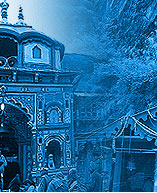Shri Badrinath ji
Shri Badrinath ji ji (Shri Badrivishal ji) is situated in the lap of Nar-Narayan
Parvat, with the towering Neelkanth peak (6,597mts.) in the background.
Also known as the Vishal Badri, the largest among the five Badris, it is
revered by all as the apt tribute to Lord Vishnu.
It is believed that to revive the lost prestige of Hinduism and to
unite the country in one bond, Adi Guru Sri Shankaracharya built four
pilgrimage centres in four corners of India. Among them were Badrikashram
(Badrinath ji) in the north, Rameshwaram in the south, Dwarkapuri in the
west and Jagannath Puri in the east. Badrinath ji situated at an elevation
of 3,133 mts. is considered to be amongst the most pious.
The revered spot was once carpeted with wild berries which gave it the
name 'Badri Van' meaning 'forest of berries.' Built by Adi
Shankaracharaya, the philosopher-saint of the 8th century, the temple
has been renovated several times due to damage by avalanches and
restored in the 19th century by the royal houses of Scindia &
Holkar. The main entrance gate is colourful & imposing popularly
known as Singhdwar.
Shri Badrinath ji Temple
The opening date of Badrinath ji Temple is fixed
on Basant Panchami by Raj Purohit and closure date is fixed on
Vijaydashmi by Mandir Committee. The temple opens every year in the
month of April-May & closes for winters in the third week of
November. Joshimath is the winter deity of Badrinath ji.
Special booking of pujas can be done at Badrinath ji Mandir Committee by
paying some fees. The pooja is organized before the temple is open for
general public. Some festivals celebrated in Badrinath ji are: Mata Murti
ka mela, Krishna Janamashtami and Badri-Kedar utsav.
Places to Visit Shri Badrinath ji
Badrinath ji - Various places of interest for
every kind of visitor. While there is Tapt Kund, Panch Shila, Narad
Kund, Brahma Kapal for pilgrims, at the same time there is Neelkanth
Parvat and Vasudhara fall for the nature lovers.
Tapt Kund
Tapt kund is a natural hot water pool fed by a sulphur spring which is
said to be the abode of Agni, the god of fire. It is customary to bathe
before entering Sri Badrinath ji temple. This water has a temperature of
130 degrees C. To the left of this pool is the Surya Kund fed by a
branch of the same thermal spring. These waters are said to be very
nourishing to the body. The Alakananda flows swiftly just below these
kunds and the boiling water falls into the icy waters of the river
giving rise to clouds of steam.
Panch Dharas
The Panch Dharas (five streams) which are famous in Badrinath ji are
Prahlad, Kurma, Bhrigu, Urvashi & Indira dhara. The most striking of
these is the Indira dhara, about 1.5 km north of the town Badaripuri.
Bhrigudhara flows past a number of caves. The one on the right of river
Rishi Ganga, originally from the Neelkanth range is Urvashi dhara. Kurma
dhara water is extremely cold whereas Prahlad dhara has lukewarm water,
which glides majestically down the rocks of Narain Parvat.
Panch Shilas
Aound the Tapt Kund there are five blocks of mythological importance
calledNarad, Narsimh, Barah, Garur & Markandeya Shilas (stone).
Standing between Tapt and Narad Kund is conical formed Narad Shila. It
is said that the sage Narad meditated on this rock for several years.
Standing in the waters of Alaknanda just below the Narad Shila is a huge
stone looking like a lion with its gaping jaws and hooked claws. It is
said that Bhagwan Narsimh after killing the demon King Hiranyakashyapa
remained in the shape of a block of stone forever.
Sheshnetra
1.5 km away is a boulder having an impression of the legendary snake,
better known as the Sheshnag's eye (Shesh meaning Sheshnag and Netra
meaning eye).
Charanpaduka
3 km away is a beautiful meadow carpeted with wild flowers in the
summer. Here is a boulder bearing the footprints of Lord Vishnu. It is
said that when Lord Vishnu descended from Vaikunth (the heavenly abode
of Lord Vishnu) he stepped on this boulder. The area is a steep climb
from the town and is full of caves & boulders.
Neelkanth
A pyramidal shaped snowy peak (6,597 mt) towering above Badrinath ji,
presents a dramatic sight. It is popularly known as the 'Garhwal Queen'.
Best Time to visit Shri Badrinath ji
The best time to visit Badrinath ji is between
May-June and September-November. Due to heavy rainfall in the area,
visitors may face difficulty reaching the temple during monsoon season
(late June to Aug). Tthe temple usually remains open from first week of
May to 2nd week of November.
CLIMATE (Weather) in Badrinath ji Summer: Cool during the
day and cold at night.
Winter: Snow-bound. Touching sub-zero.
CLOTHING Summer: Light Woollens.
Winter: Very Heavy Woollens.
How to reach Shri Badrinath ji
Badrinath ji is well connected through road. The
National Highway (NH 58, total length 538 km) from Delhi to Mana is
accessible throughout the year.
There are two routes to Badrinath ji from Delhi:
- Route 1: Delhi - Rishikesh : 243 km by
rail/road, Rishikesh-Badrinath ji :297 km by road.
- Route 2: Delhi - Kotdwara: 300 km by
rail/road, Kotdwara-Badrinath ji-327 km by road.
- Travel Tip to Badrinath ji: There is a gate in Joshimath enroute
Badrinath ji to manage the traffic. This gate opens at a interval of 2
hours from 6 am to 4 pm. Pilgrims who reach Joshimath after 4 pm
have to stay in Joshimath and continue their journey next day.
Railway: Nearest railheads are at Rishikesh 297
km away and Kotdwara 327 km away, which are connected with major cities
of North India." Rishikesh is directly connected by rail with
Howrah, Bombay, Delhi & Lucknow."
Airways: Nearest airport is Jolly Grant, Dehradun
(317kms.)
|











